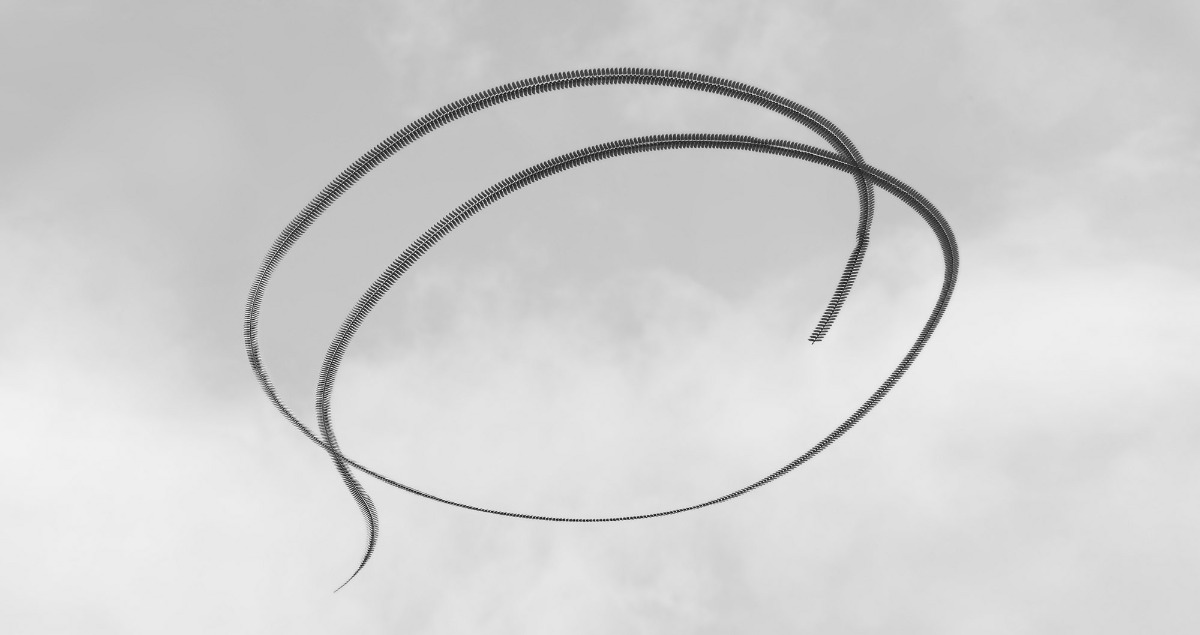
Making the Invisible Visible
A few impressions from Why Look at Animals?, the exhibition that opened last week at the National Museum of Contemporary Art, Athens (EMΣT)
“For a long time, animals were not considered a ‘serious’ subject in art. With rare exceptions – like British horse painting, for example – you usually see animals as accessories, never as subjects. There has always been a lot of prejudice, just as there still is in many other areas of the art world. You start seeing exhibitions about the environment, ecology, and climate change – but even then, when animals appear in art history or contemporary art, it's mostly about how artists see them. Not about what they really are, their condition, how they live, and how we, humans, affect the way they live. So for me, it was very important to highlight this ethical dimension,” says Katerina Gregos, Artistic Director of the National Museum of Contemporary Art, Athens (EMΣT), on the opening day of the ambitious exhibition that spans all seven floors of the museum and brings together the work of nearly 60 artists under the title: Why Look at Animals? A Case for the Rights of Non-Human Lives.
Her remark was in response to my question about why, despite having conceived the idea for such a project nearly ten years ago, no other art institution she had previously approached had been willing to take it on. In 2021, Katerina took up her position at the National Museum of Contemporary Art in Athens and completely redefined its mission – transforming it into a true museum of humanism and contemporary art that recognizes its responsibility toward the world, while deliberately avoiding the use of pat slogans or accusatory rhetoric. In late 2023, she and her team launched a series of exhibitions and projects by women artists, united under the overarching theme “What If Women Ruled the World?”. We published a detailed interview with Katerina about this initiative in 2024.
Lin May Saeed, Elephant Relief (V04), 2021. Styrofoam, acrylic paint
138 x 200 x 15 cm. Courtesy of Lin May Saeed Estate and Jacky Strenz, Frankfurt / Main. Photo: Wolfgang Günzel
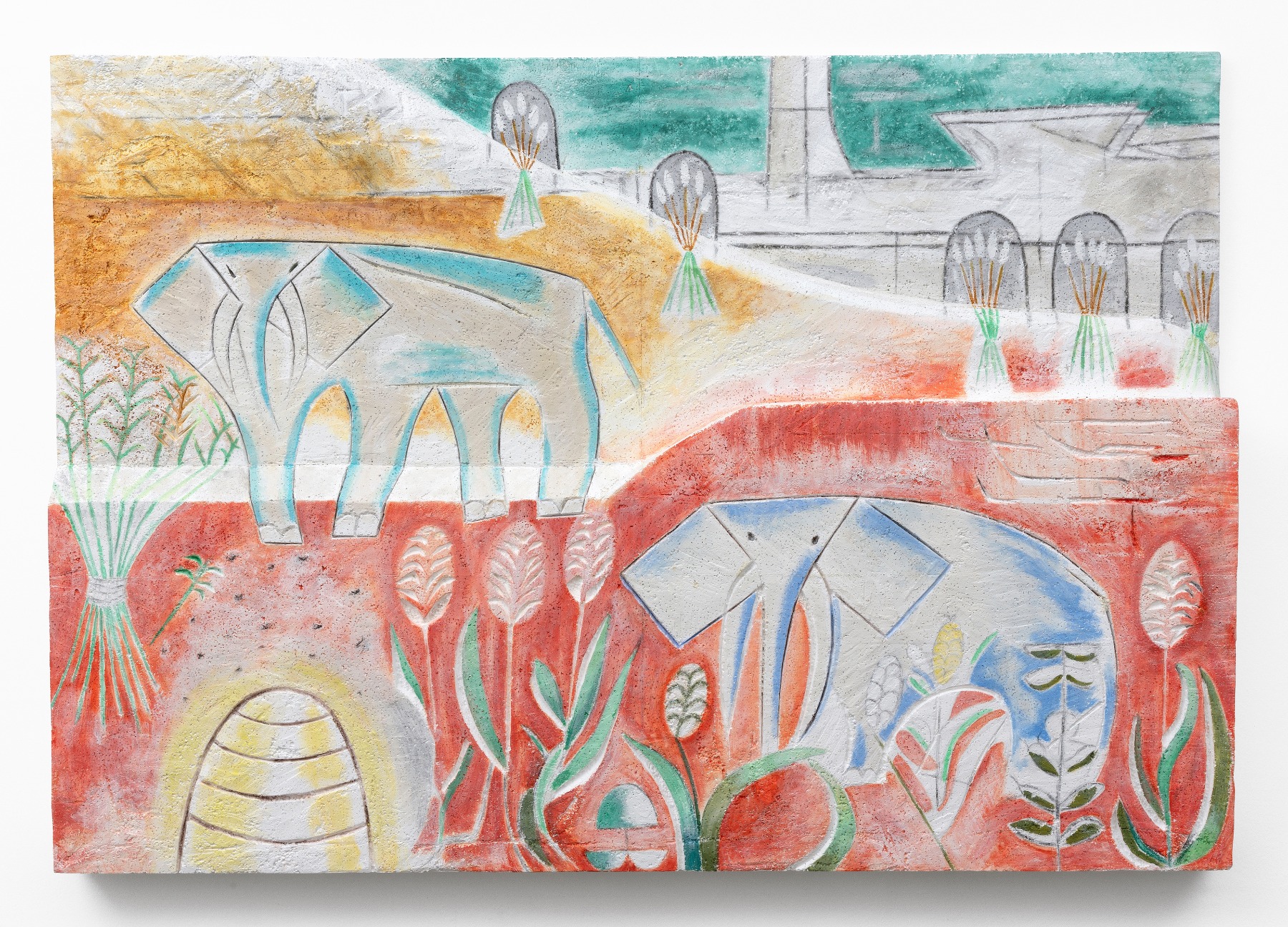
After challenging our perceptions of women and art, the time had finally come to explore our complicated relations with animals. The theme “Why Look at Animals?” is far from arbitrary. For instance, since Katerina Gregos became its director, EMΣT has become a pet-friendly museum – visitors are welcome to bring their dogs. And as Katerina points out, there has never been a single issue with that.
The title of the exhibition is taken from John Berger’s 1980 essay “Why Look at Animals?”, which explores the evolving relationship between humans and animals, particularly in the context of modernity. “As Berger noted, animals were once central to human life but have gradually disappeared from view. Modernity pushed them to the margins – confined to zoos, circuses, entertainment, or transformed into packages on supermarket shelves (deliberately disconnected from their means of production, their origins and the reality of their life and death),” writes Katerina Gregos in her introduction to the exhibition.
In contrast to the prevailing status quo, Katerina and her team aim to make animals visible, to shift our perspective on how we see them, and to give them a voice. That is why, for example, Joanna Zielińska, senior curator at the Museum of Contemporary Art in Antwerp (M HKA), was invited to participate in the project. She presented a selection of field recordings and audio works created by artists and researchers working in fields such as zoomusicology and eco-acoustics. “Laughing rats, dancing bees, and inaudible frequencies are just some of the sounds visitors may encounter in the Sonic Space, a guest project hosted by Zielińska,” notes the exhibition catalogue. Actually, the Sonic Space is a field of speakers connected by visible cables, where an ongoing "discussion" unfolds. It offers visitors a unique opportunity to listen to this audio-poem of communication in which the voices and sounds of vastly different living beings – who would normally exchange messages only with their own kind – come together in a shared acoustic environment.
Paris Petridis, Vironia, Serrès, 2018. Inkjet print 60 x 90 cm. Courtesy of the 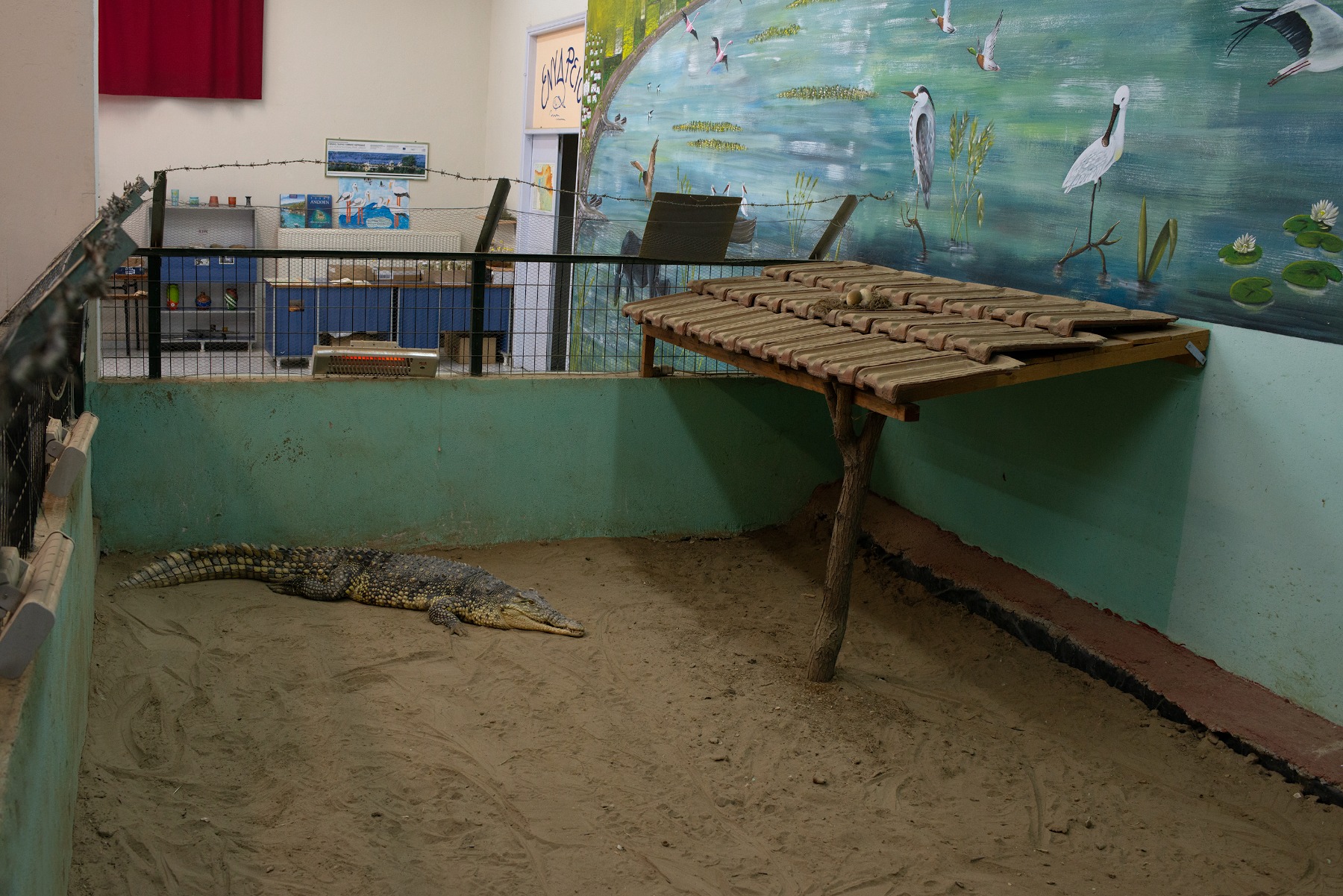
This installation is located on Level -1 of the museum, where some of the most poignant and unsettling interpretations of the exhibition’s theme can also be found. Among them is a series of photographs by Greek photographer Peris Petridis, focusing on the severely limited spaces humans allocate to their animals. Much more harrowing is the video work High-Rise Pigs (2025) by Singaporean artist Ang Siew Ching, which documents the world’s largest pig farm – a 26-story vertical facility in China’s Hubei province, where generations of animals are raised without ever seeing daylight, subjected to genetic selection for stronger legs capable of supporting their overgrown bodies, and for increased numbers of teats in sows to feed larger litters. This industrial complex is also the site of frequent guided tours for children and adults. Here, this ruthless and brutal mechanism of meat production is presented almost like a miniature Disneyland – complete with scale models of each floor, cartoonish pig figurines, and large video panels that illustrate the animals’ life cycle. On the surface, it may seem logical to educate children about where their food comes from. But in this case, the simplistic, pop-cultural aestheticization of meat production is so stark and so jarring that it turns the viewer inside out – forcing a confrontation not just with how meat is made, but with how that violence is vividly and attractively packaged for both physical and cultural consumption.
High-Rise Pigs, 2025 Single channel video, 18′ 6′′ Courtesy of the artist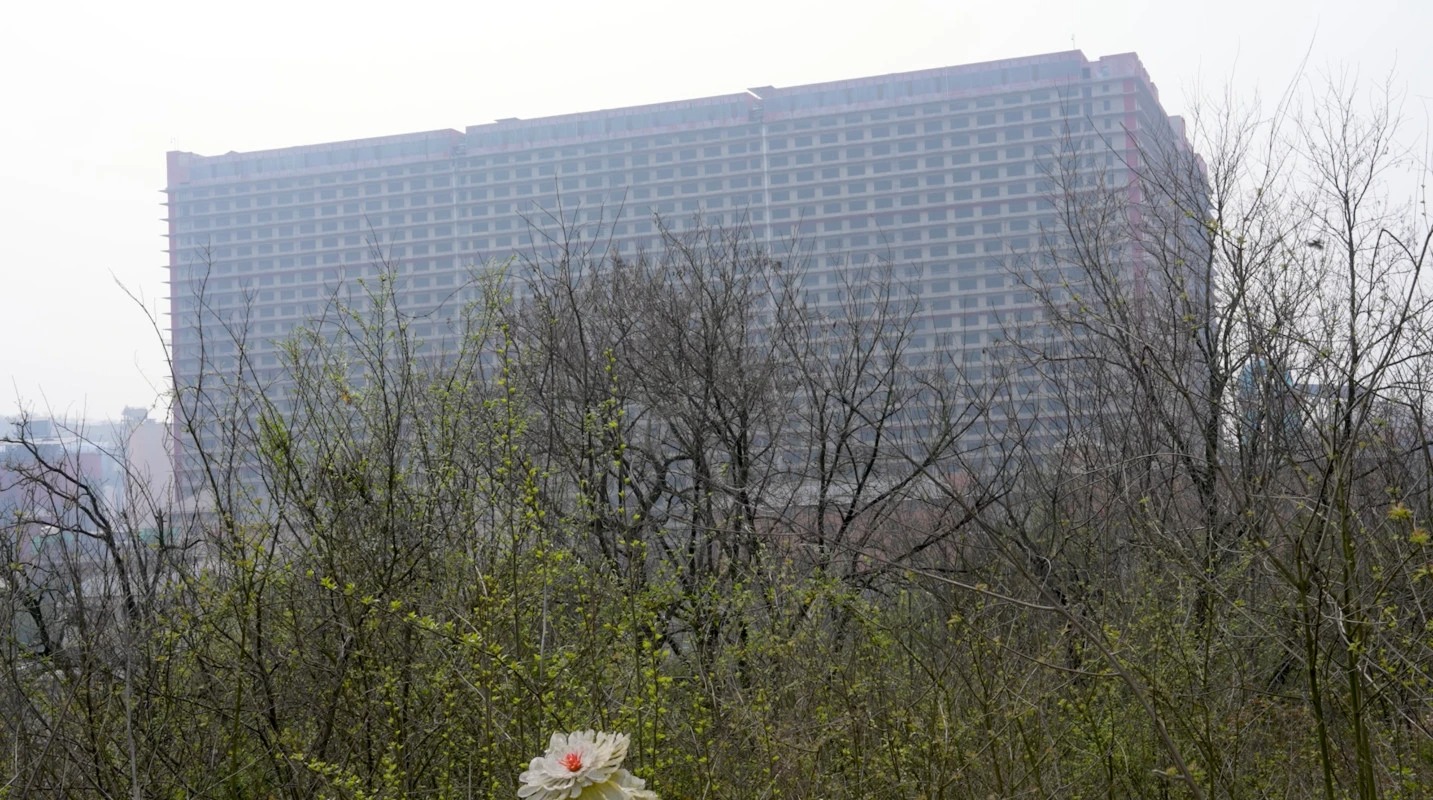
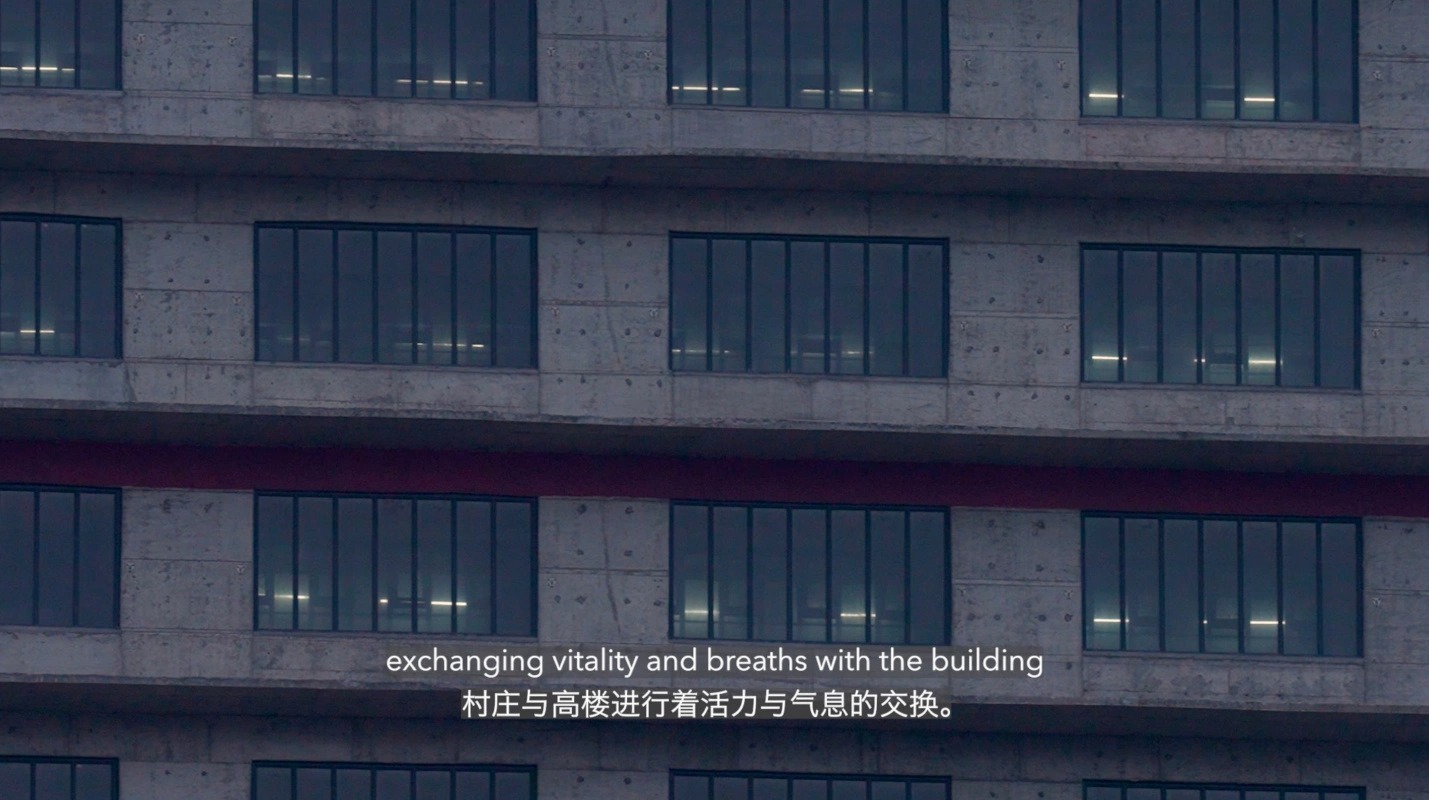
On the Level 2, visitors encounter an impressive video work by Greek artist Janis Rafa – a three-channel video installation titled The Space Between Your Tongue and Teeth (2023), an immersive film built around a highly cinematic narrative. While ostensibly centered on the relationship between humans and horses, the work casts a broader gaze on the intersection of desire and control, care and exploitation. “This is about – who’s on top,” she tells me during our conversation (a full interview with the artist will be published in early June). Set in a closed environment where horses are trained for racing, the film shows animals confined indoors, forced to run on electric treadmills – a haunting choreography of discipline and endurance.
Installation view of Janis Rafa’s solo exhibition “We Betrayed the Horses”, 2025. Produced by ΕΜΣΤ. Courtesy of the artist. Photo by Paris Tavitian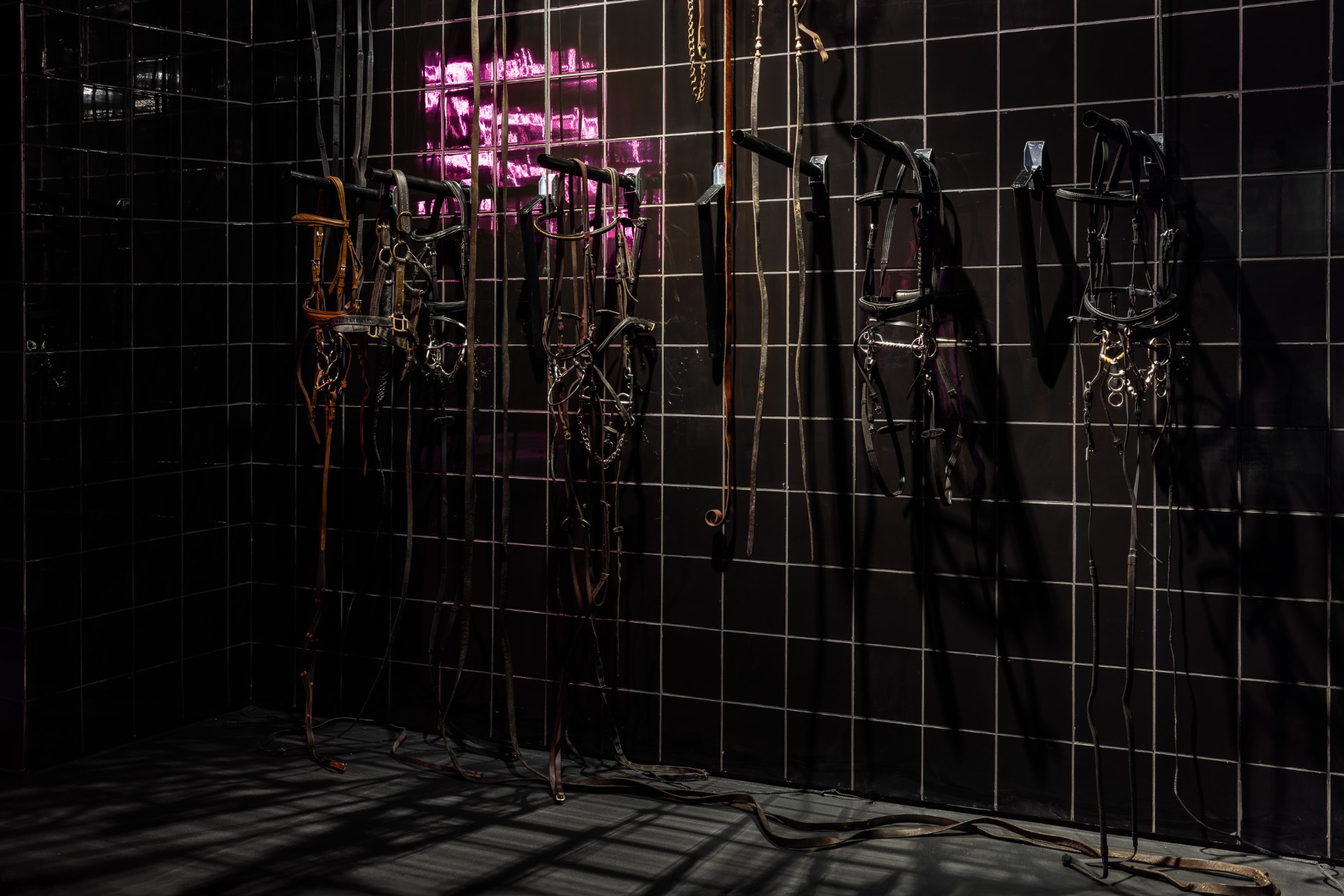
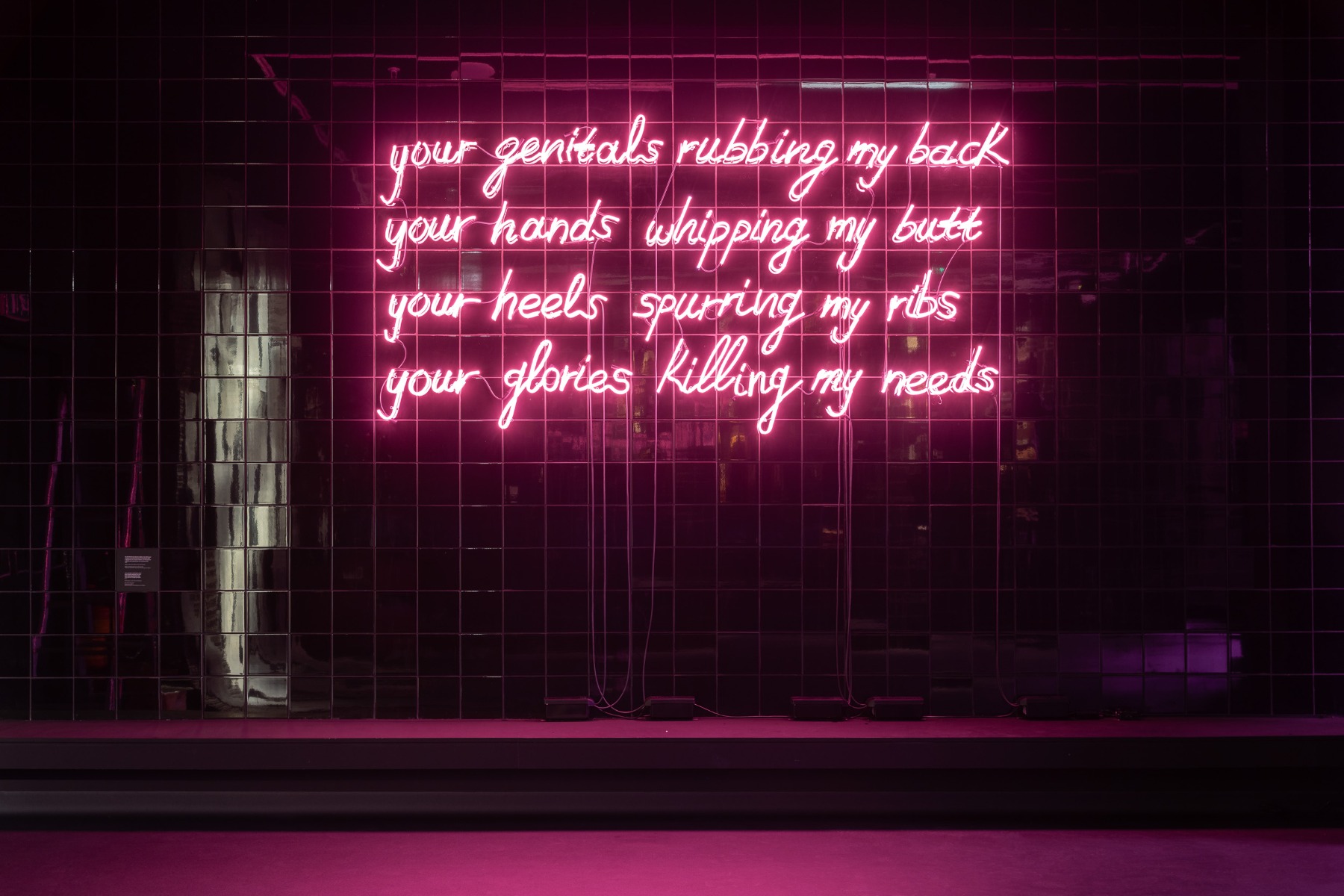
This work finds continuation in a striking solo exhibition, presented by Janis Rafa on the museum’s third floor, titled We Betrayed the Horses. It comprises a series of new pieces in various media, created specifically for EMΣT. Here, the world of taming and domination unfolds almost like a BDSM club, filled with elaborate devices and strategies designed to subdue and control horses – a space where the aesthetics of power, pain, and submission are laid bare.
Humans not only consume animals and subjugate their will through violence; for decades, they have also sent them into space as subjects of experimentation – beings forced to endure all the risks of space travel "in their own skin." This is the focus of Jonas Staal’s work Exo-Ecologies (2023), a tribute to the monkeys, mice, dogs, seeds, worms, tortoises, and frogs that were launched into the unknown, exposed to the brutal extremes of acceleration and isolation. “I personally find this heart-breaking,” says Katerina Gregos during our walk through exhibition. “I cannot imagine what it might be like to be sent out into space without understanding, into a capsule where you can’t move, and you can’t exercise your natural behaviour. I find it really chilling.”
Ingresso Animali Vivi, 2023. Experimental documentary film. Single channel video, 14′ 40′′ 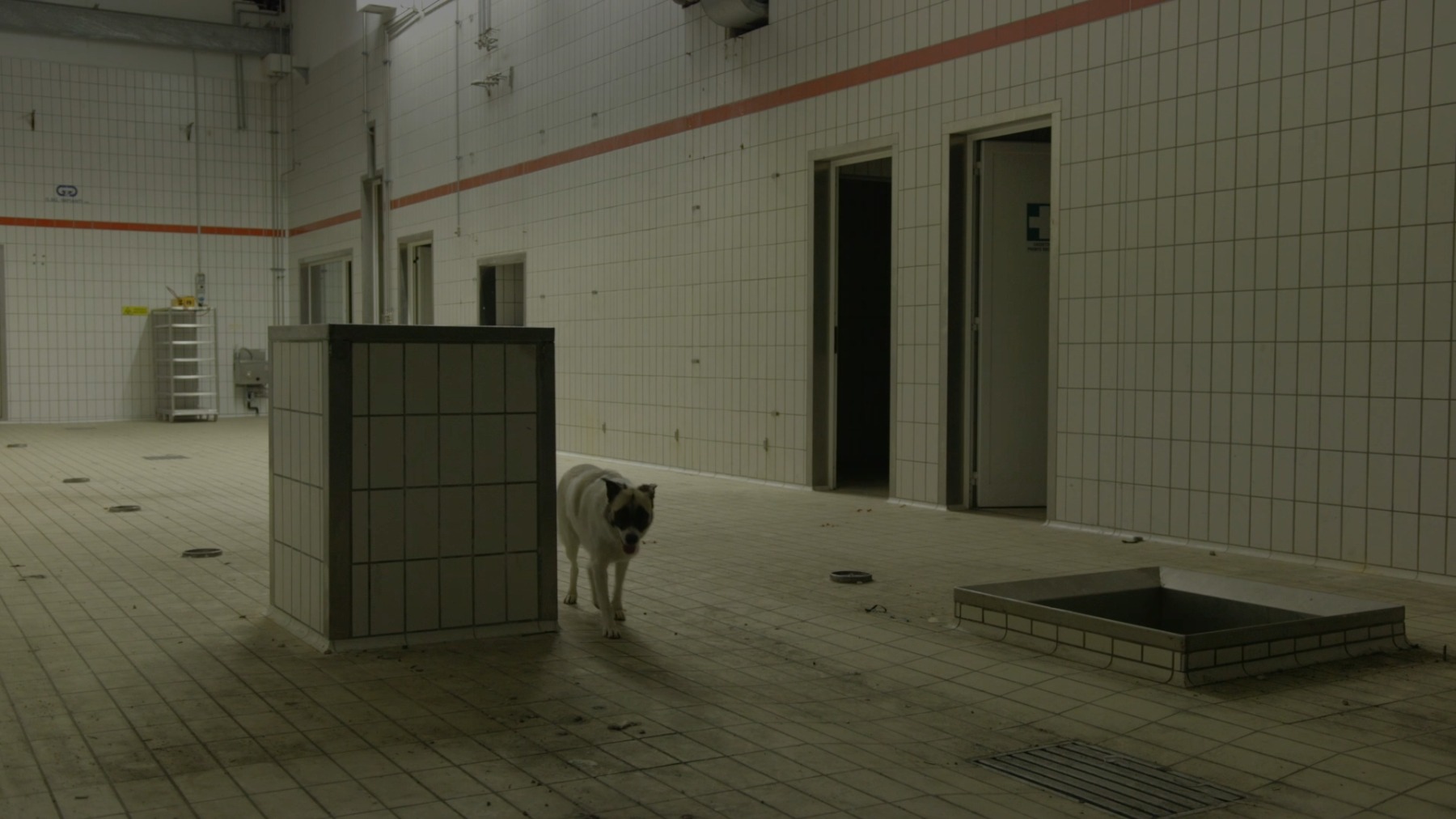
Perhaps the most subtle and poetic contribution to this theme appears in Ingresso Animali Vivi (2023), an experimental documentary by Croatian artist Igor Grubić. In the film, a large and inquisitive dog roams through the now-defunct premises of a slaughterhouse somewhere in Italy. He sniffs at closed doors, nudges iron-barred walls, and explores the space where destruction has come to a halt – a site of former violence, now silent. “The non-human point of view chosen by the artist,” notes the curatorial text, “is intended to evoke a sense of compassion and empathy between the dog and the animals who, from birth, were destined to become products for our tables.”
But this exhibition is not solely tragic. Its goal is not merely to confront us with the origins of those neatly packaged trays in supermarket meat aisles. It also seeks to shift our visual perspective – to help us see animals and their lives through a different, more attentive lens.
Exhibition visitors observe the Ornithography series by Barcelona-based photographic artist Xavi Bou. Photo: Arterritory.com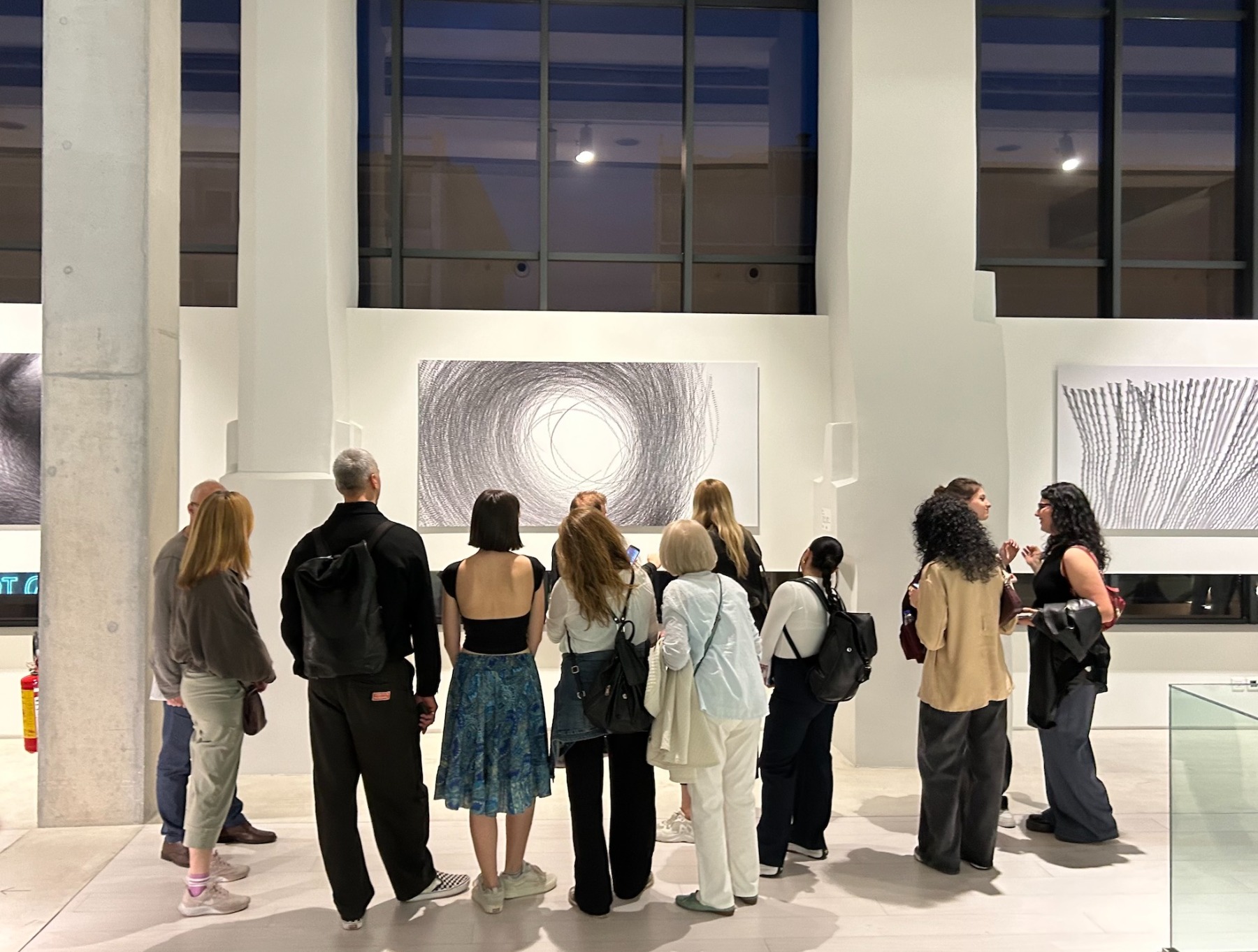
One artist who quite literally gives shape to the unseen is Barcelona-based Xavi Bou. “His Ornithographies (2014–2024) series captures the fleeting beauty of different bird species in flight and transforms it into a set of fascinating visual narratives.” Usually we see birds in motion as fleeting dots on the horizon – Xavi, using ultra-high-speed cinema cameras, dissects their flight into thousands of individual moments and composes them on a single visual plane. “Basically, Xavi renders what is invisible to the human eye – he gives it a form, a shape, a pattern, and a recognizability,” says Katerina Gregos about these images.
Installation view: Emma Talbot, Human/Nature, 2025. Produced by ΕΜΣΤ. Courtesy the artist and Galerie Onrust, Amsterdam. Photo by Paris Tavitian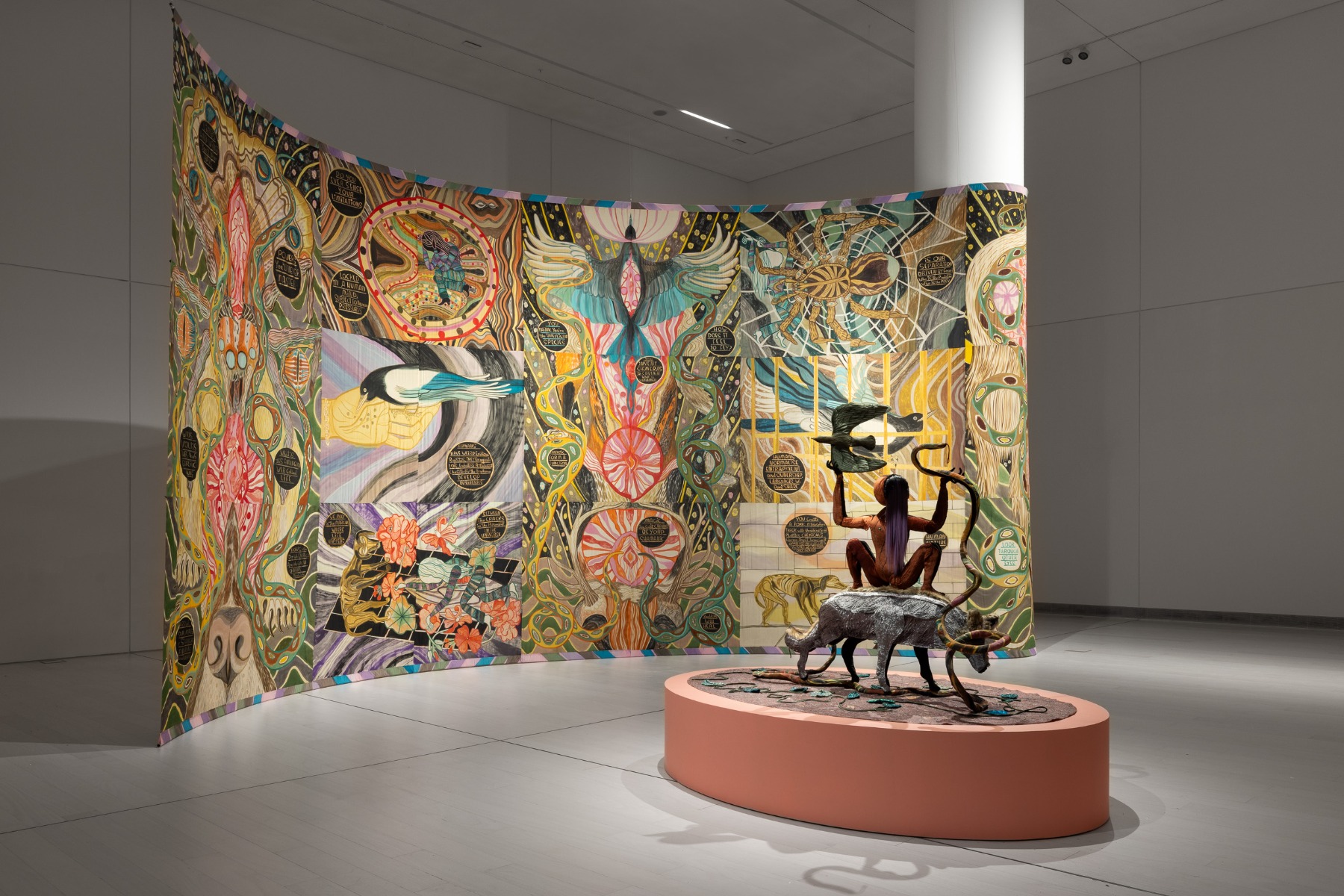
There are also beautiful examples of ecofeminism on display – such as Human/Nature (2025), a monumental textile installation made of painted silk, newly commissioned for EMΣT and the exhibition, by British artist Emma Talbot. It resembles an impressive sanctuary dedicated to the interwoven relationships between the natural world and humanity.
This theme is further explored through the delicate, wild, and exquisite works of Italian artist Marta Roberti. “She deconstructs Western binary thinking, bringing attention to what has historically been othered and exoticized: women, animals, and nature. In her drawings, Roberti explores the relationship between East and West, reworking myths and their representations,” states the exhibition catalog. Self-portrait as Saint Olivia lying on jaguar (2024) and Self-portrait as Saint Olivia wrapped in a snake (2024) present stunning images of harmony and the coexistence of human and non-human animals.
Marta Roberti, Self-portrait as Saint Olivia lying on jaguar, 2024. Drawing and collage with graphite and oil pastel from handmade carbon paper on Taiwanese Gampi paper, 240 x 190 cm. Courtesy of the artist and z2o Sara Zanin, Rome. Photo: Giorgio Benni
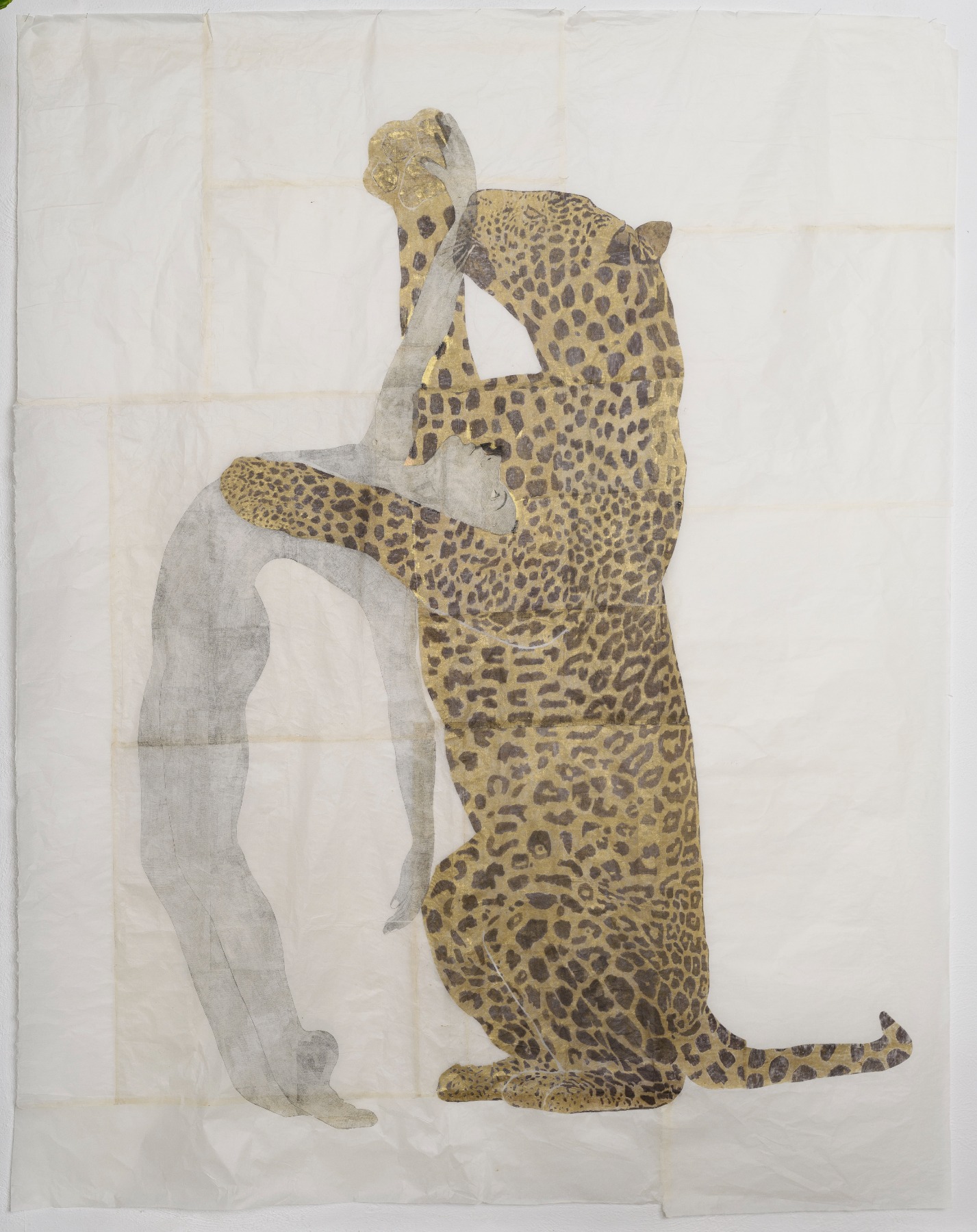
But the artists are not only imagining and crafting idealized visions of interspecies harmony. Many are also confronting real and urgent threats – such as the increasingly discussed danger to bee populations. Belgian artist Anne Marie Maes conceived and built her experimental rooftop garden in Brussels, Hortus Experimentalis, as a living laboratory for studying bees, plants, and bacteria. “In order to protect these fragile but vital insects, Maes has designed a mobile hive – a refuge – customised to their needs. Manufactured from microbial skin and bacteria that register environmental influences and respond to them, the hives are meant to provide protection to the bees. They offer a concrete starting point for an exploration of possible futures through artistic research on material science and biotechnology, reflecting the artist’s belief in multi-species collaboration”.
Anne Marie Maes, Intelligent Guerrilla Beehive (Bee Agency), 2017-2019. Organic materials & 3D prints, electronics, solar panel, Raspberry Pi. Dimensions variable. Courtesy of the artist. Installation view: M ΗΚΑ, Museum of Contemporary Art, Antwerp. Photo: Kristien Daem
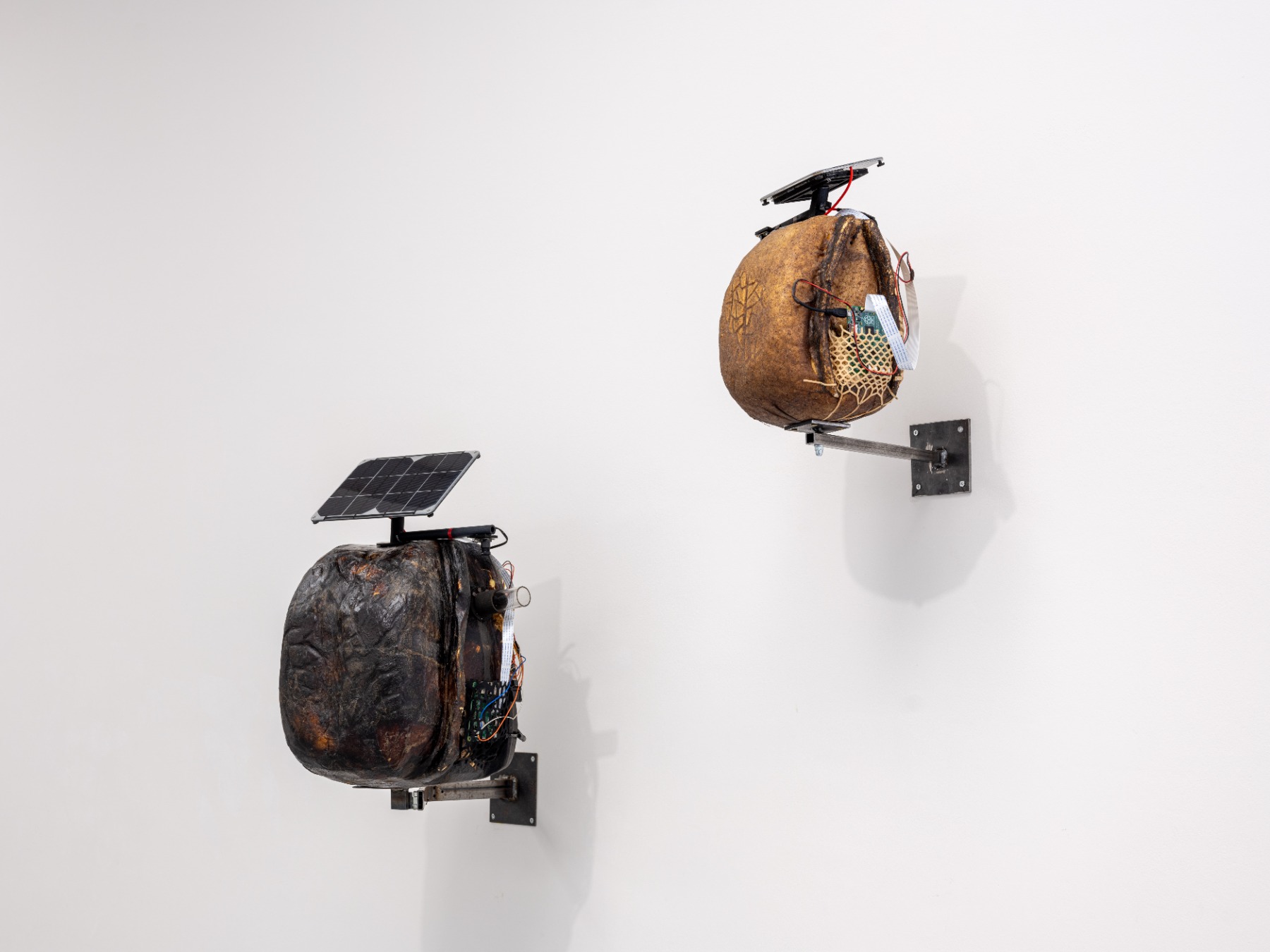
The theme of refuge, care, and support is continued by Greek artist Kostis Velonis. He draws inspiration from the world originally imagined in comic form by American artist Charles M. Schulz – the universe of Snoopy, Woodstock, and other beloved characters. In Velonis’s interpretation, these creatures build shelters for one another – spaces of calm and strength, partially inspired by the spatial ideas of Russian avant-garde. “Of course, it’s a very playful work, very, very tender, and it speaks to the spaces we create for care and protection,” says Katerina Gregos during the press view.
Then I’m standing in front of a wall covered with birdcages of all shapes and sizes, listening to birdsong. This is Homo-Carduelis (2022), a sound installation by Oussama Tabti, an artist born in Algeria and based in Brussels. The cages are empty, but birdsong pours out from dozens of small speakers – one in each cage. And yet, it’s not quite birdsong. These are human voices, masterfully imitating birds – performed by people for whom this is, in fact, a profession. “I discovered a tradition in the south of France that has been passed down through generations, and I knew instantly this was exactly what I needed,” Oussama Tabti tells me. As Katerina Gregos explained earlier: “We hear the sound of a goldfinch – a bird that, in Algeria, holds deep meaning, symbolizing love and freedom. But here, instead of seeing the bird inside the cage, we only hear its song. And that song isn’t even from the bird itself – it’s made by humans, mimicking its voice. So you can already sense how many layers this piece is working with. It speaks of freedom, yes, but also raises the question: who is really caged? Is it the birds – or us? Have we, in some way, imprisoned ourselves? And then there’s the haunting possibility that one day these birds might disappear altogether, and the only trace left of them will be these human-made sounds – echoes of something we’ve lost”.
Oussama Tabti. Homo-Carduelis, 2022. Sound installation. Bird cages, speakers, 33′ (loop). Dimensions variable. Collection of EMΣT. Photo: Arterritory.com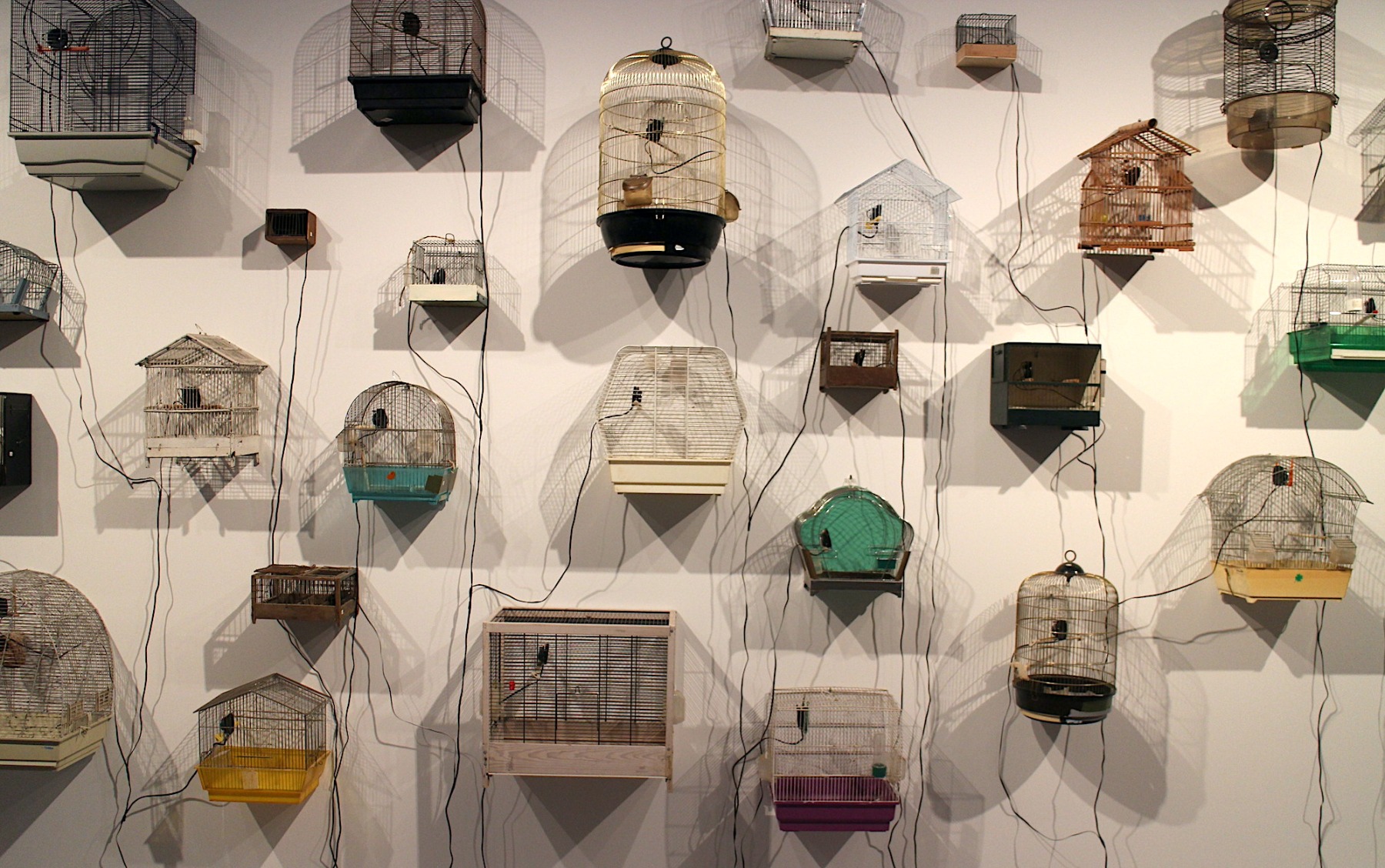
This is undoubtedly an important and timely exhibition, and I’ve only touched on a small selection of the works displayed across the museum’s seven floors, open for our interpretation until February next year. In this sense, EMΣT also stands as a kind of shelter for the idea of equality and justice among different species.These ideas extend beyond the museum walls and into Athens itself: on one of the museum’s exterior walls, a giant “ticker tape” runs – but instead of political news, wars, or stock market fluctuations, it broadcasts updates from the plant and animal kingdoms. This is Today in Athens... (2025), a work by British artist Marcus Coates. Based on research conducted in the greater vicinity of Athens, a calendar has been compiled and it contains 365 entries. Each one reveals the various daily phenomena occurring in the lives of nearby plants and animals: “spiders devouring their webs, young rabbits venturing from their parents, beetles emerging from underground, birds migrating. These subtle yet vital events, once markers of seasonal change, have faded from our collective daily consciousness. They are happening all around us, but we either cannot see them or are oblivious to the fact”, notes the exhibition catalog. And this is precisely the essence of the entire Why Look at Animals? project – to change the way we see, to make the invisible visible, and to remember what has been forgotten.
Upper image: Xavi Bou. Ornithography 195#, 2021. (Accipiter nisus, Eurasian Sparrowhawk, Castelló d’Empuries, Catalonia)